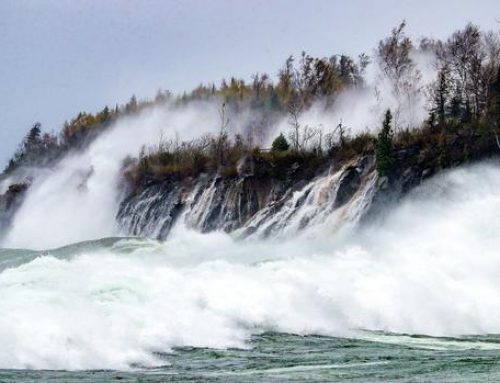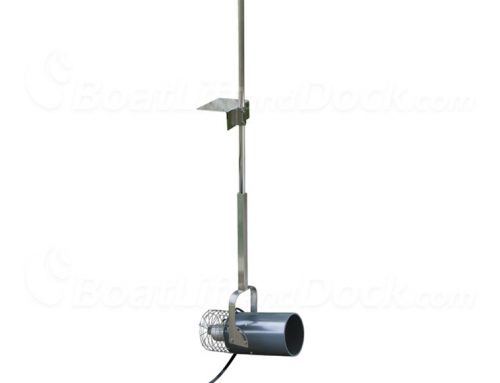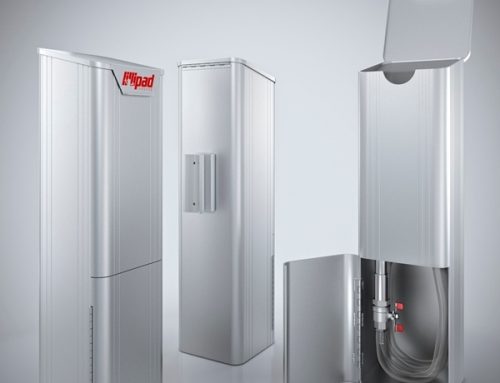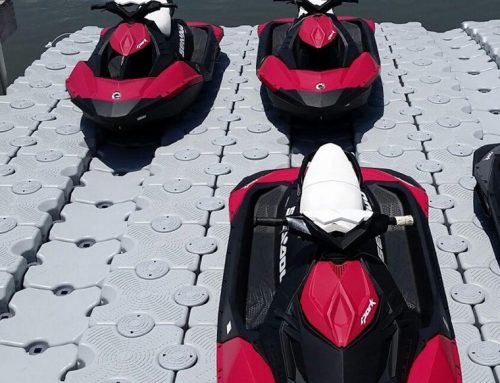In part one, we discussed the basic details that you will encounter when designing and installing a new dock on your lake or river. Here, we will discuss, in detail, the variations or options that are available to you when designing and planning the installation of your lake dock system. We will cover the configuration (span and layout), the types of systems available, connection type, and the available decking options. Some of these decisions will be based on your technical needs, while others will be a matter of personal preference.
Part Two
Span or Length
This bit of information is dependent on how far you need or want your dock to extend and whether or not you are planning to place any equipment, such as your boat lift or jet ski along the span. If you have experienced a loss of water depth due to drought, or any significant increase in water depth, then your span will be determined to a certain extent by these realities. You may also be limited by the “right of way” you will have to work within if your lake community or regional environmental regulations have set certain limitations.
The “connection”
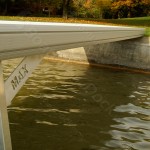 The “connection” here is a consideration of two different things. The first is your connection to address will be at the shoreline, and the second will be your connection to the lake bottom. The first “connection” should be relatively easy to determine. If you have a sea wall you will need some kind of strong connection at that point, either through a solid bracket or one that will flex, especially if you choose a floating system. If you have a shoreline or bank, then you will need to determine the best way to arrange the initial dock section and its support hardware.
The “connection” here is a consideration of two different things. The first is your connection to address will be at the shoreline, and the second will be your connection to the lake bottom. The first “connection” should be relatively easy to determine. If you have a sea wall you will need some kind of strong connection at that point, either through a solid bracket or one that will flex, especially if you choose a floating system. If you have a shoreline or bank, then you will need to determine the best way to arrange the initial dock section and its support hardware.
The underwater connection to the lake or river bottom, which we covered in part one, requires a bit more thought. This is where the information you gathered regarding your “bottom conditions” and your water depth comes in to play. This will enable you to choose the length of the legs on your support framework and the style of base pad that is best.
Freestanding or Floating System
 This decision will probably be a combination of necessity and personal taste. If you are installing the dock with relatively stable and predictable tidal variations, workable bottom conditions, and water that isn’t excessively deep, you can probably go with a free standing system. However, if you have strong tides, live on the Gulf, one of the coastal areas, or have excessively deep water, you may need to go with a floating system that can more easily adjust to these conditions, especially if your water depth is too great for standard dock posts.
This decision will probably be a combination of necessity and personal taste. If you are installing the dock with relatively stable and predictable tidal variations, workable bottom conditions, and water that isn’t excessively deep, you can probably go with a free standing system. However, if you have strong tides, live on the Gulf, one of the coastal areas, or have excessively deep water, you may need to go with a floating system that can more easily adjust to these conditions, especially if your water depth is too great for standard dock posts.
Dock Configuration
This decision, much like the type of dock system you go with, is in large part a personal one. You have to look at and use the dock system that you choose, so you should get the one you want within the framework of any limitati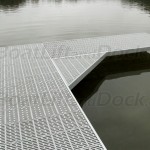 ons you have to deal with.
ons you have to deal with.
What this means is that you want the dock to fulfill your needs without violating any local or community restrictions. If you need a short, straight span, then all the information you have gathered will help you make your decision. However, if you need any platforms or slips for things such as boat lifts or PWC’s, then your design can become more complex and expensive. The best bet is to consult a qualified dealer to finalize your design.
Decking
This decision can be influenced by several factors such as personal taste, cost, weight, and resilience to the environment, and in the end boils down to what’s available and which factors rank the highest for you. Your options now include wood, aluminum, and composite plastics of various designs, textures, and colors. The wooden deck board is the most common and familiar but in recent years has been employed in combination with aluminum side rails, significantly reducing the overall weight of this type of dock.
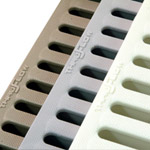 Aluminum decking is very versatile and is available in several designs that increase traction and decrease overall weight and heat retention from direct sunlight. The molded composite plastics, particularly the design of Thru Flow decking, is a relatively new product that brings an increase in versatility and longevity to the dock market. This product is flexible and light weight; allowing water to pass freely through decreasing the drying time from wave action and rain. Thru Flow decking, due to the properties of the material, does not retain heat from the sun and is therefore less likely to cause any discomfort on hot summer days. Also, this style of decking will not result in any significant “glare” from the sun like the aluminum option.
Aluminum decking is very versatile and is available in several designs that increase traction and decrease overall weight and heat retention from direct sunlight. The molded composite plastics, particularly the design of Thru Flow decking, is a relatively new product that brings an increase in versatility and longevity to the dock market. This product is flexible and light weight; allowing water to pass freely through decreasing the drying time from wave action and rain. Thru Flow decking, due to the properties of the material, does not retain heat from the sun and is therefore less likely to cause any discomfort on hot summer days. Also, this style of decking will not result in any significant “glare” from the sun like the aluminum option.
You may encounter other factors not covered in this article when you begin your lake dock installation plans and it is best to consult a qualified dealer from the outset. Doing this will save you allot of time, frustration, and money; getting you from beginning to end in a reasonable amount of time. As always, if you have a story or issue that we haven’t covered, please feel free to comment and share.
© 2013 BoatLiftandDock.com


